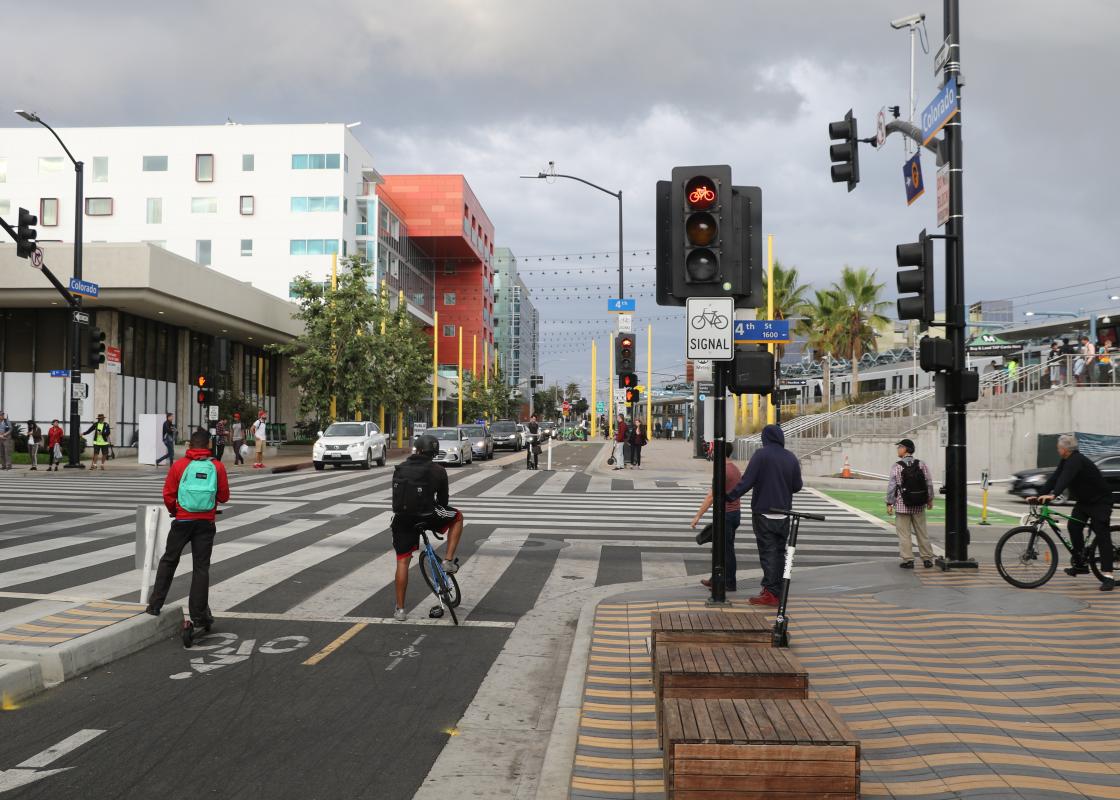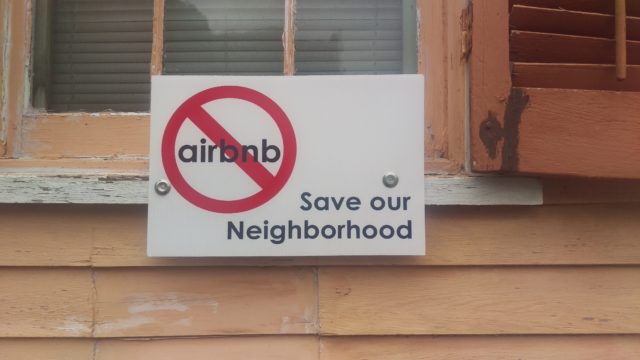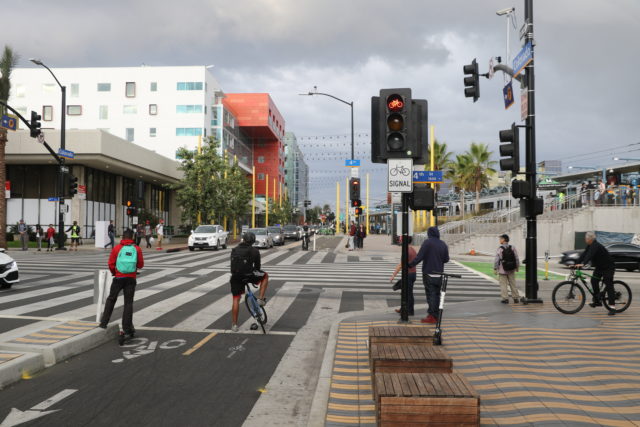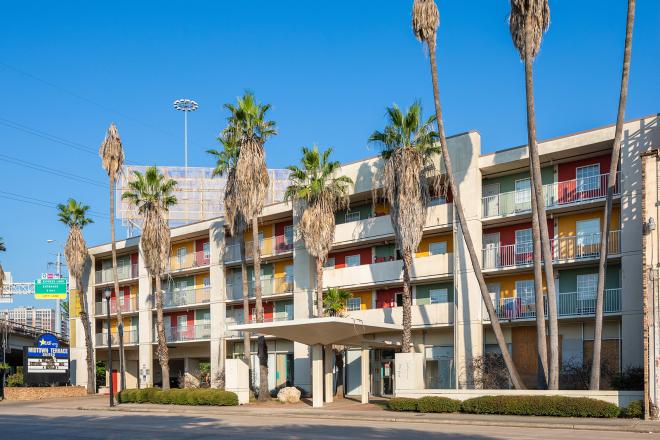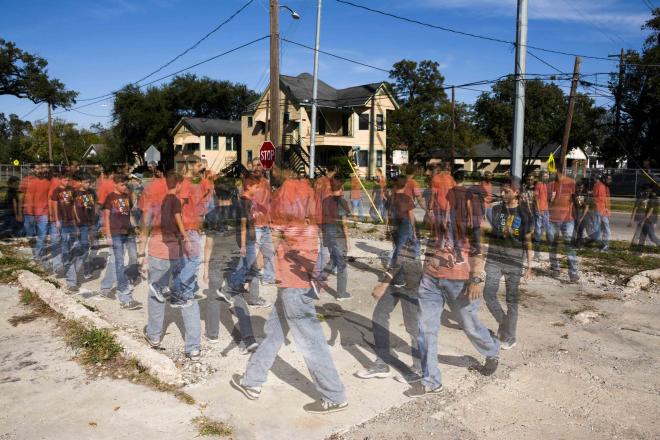This article is part of a special series on Sharing, the theme of the Rice Design Alliance Fall 2018 Lecture Series organized in collaboration with PLAT Journal. Christof Spieler is Vice President and Director of Planning at Huitt-Zollars, where he does landuse, transportation, and open space planning across the United States, and a Senior Lecturer at Rice Architecture. As a board member of Houston METRO from 2010 to 2018, he initiated a re-design of the entire bus network. His book Trains, Buses, People: An Opinionated Atlas of Transit is coming out in October from Island Press.
Never mind Uber, Lyft, Limebike, Bird, and Airbnb: the sharing economy dates back a few millennia.
Cities are perhaps the greatest human invention. Fundamentally, what they do is bring people together. A city maximizes how many other people someone can reach with a reasonable trip. Access to more people means access to more jobs, more education, more places to eat, more places to shop, more potential friends, more potential life partners. Our lives aren’t measured by our ability to move; they’re measured by our ability to get to someone. It’s access that matters, not mobility, and cities provide access. Access isn’t just an individual benefit. Bringing people together creates economic activity: more customers, more suppliers, more capital. Bringing people together encourages systems of organization. Bringing people together generates ideas. Bringing people together inspires art. For several thousand years, people have been drawn to cities because of this.
But all this opportunity comes with a trade-off. Access comes with crowds. When we gather together, we each get less space. We can’t easily separate ourselves. We have to learn to share. We’ve never really been good at this; the innumerable social norms and regulations that attempt to govern our behavior within cities testifies to that. With every new technology, every new social practice, every new economic system, we have to reinvent and restructure those rules. If we can’t figure out how to occupy the limited land and shared spaces of a city together, we can’t get its benefits.
What we are now calling the “sharing economy” has triggered new rounds of argument about what these arrangements should be. Cab drivers, seeing their clearly defined role in a city slipping away, are fighting Uber and Lyft. Protesters stand in front of Google buses in San Francisco. Condo boards sue to block Citibike stations in New York. Homeowners associations lobby against Airbnb. People are alarmed when, one day, hundreds of electric scooters appear on the street in Austin, Dallas, and San Antonio. And so, city governments debate whether to adopt new rules, state governments attempt to override them, and political alliances are recrafted.
None of these debates are new; the basic issues have been debated before. An Uber is not fundamentally different than a Hansom Cab; an Airbnb is a modern boarding house. There are regulations on the books today that were the result of similar debates decades, even centuries ago.
It is worth taking a broader view: fundamentally, all these debates are about how we share space in a city.
The word “sharing” in the sharing economy is a bit of a misnomer. An Uber is not a “shared ride;” while you summon one in New York City, a car, a driver, and 200 square feet of the most sought after real estate in the nation has been dedicated to your personal use. You are sharing temporally – someone else will have the same car dedicated to them in a few minutes – but not spatially. Likewise, when you book an Airbnb in New Orleans, you’re reserving a tenth of an acre of land for your use – and only your use -- for several days. You’re not sharing; you’re apportioning. That comes at a cost. The space your Uber takes on 42nd Street can’t be filled by anyone else, and 80 people in a bus behind you will get to their destinations a bit slower because you are there. The house you booked in Bywater is not available to house a family, and one of the waiters or line cooks you’ll encounter later has to move outside of the city, put up with a longer commute, and spend less time with their family because you took that space instead.
There’s nothing wrong about taking up space in a city – we all do that. Nor is it necessarily problematic that we use money and a market to determine who gets space; we haven’t really found a better system. But we should not pretend that this system is a pure manifestation of the invisible hand. Every bit of a city is a complex balance of market forces and government regulation.
First of all, a third or more of the land in a city isn’t private. The street right-of-ways – the sidewalks and traffic lanes and parking spaces – are owned by all of us, held in trust by the city government. That’s incredibly valuable real estate – the streets in Downtown Houston have a land value well above a billion dollars. And there are many potential uses for it: through traffic, local access, parking, deliveries, bikes, pedestrians, gathering spaces, sidewalk cafes, art. Cities are constantly making decisions about how to use this space.
Secondly, the land that is private is heavily regulated. In most US cities, there are strict requirements on what uses are allowed on a piece of land and which are not. These can be to a ridiculous level of detail: before Sugar Land simplified its zoning code, the B-2 “General Business District” allowed for the printing of “Blank Books and Loose-Leaf Binders” but not “Greeting Cards.” There are requirements on how much of that land a building can occupy, specifying setbacks from streets and from other properties. There are requirements on how tall a building can be. There are requirements for how much parking it must have. There are requirements for how it must be managed. Even Houston, with no land use zoning, has many of these rules.
The regulations of public and private space are not independent. Urban life constantly crosses the property line between public and private. We have numerous laws to govern this interface: a city permit to build a driveway, extend a sign over a sidewalk, or allow a new connection between public and private. Even when a regulation applies on only one side of the property line, it’s often justified by what happens on the other. Street improvements are justified – or condemned -- by their impact on the value of the adjoining private property. Parking regulations are premised on the idea that, if private landowners do not provide parking, the streets will be overwhelmed with parked cars.
We also should not pretend that these regulations are technocratic or neutral. Some make obvious sense; prohibiting steel smelters in residential neighborhoods, requiring tall buildings to be built of fireproof materials, or mandating that new buildings not flood their existing neighbors, all protect health and welfare. But regulations always embody value judgments. Traffic engineers, for example, have long done their work based on the premise that the needs of people traveling through a neighborhood outweigh those who are accessing that neighborhood; on-street parking (which serves local businesses and residents) is considered only when it won’t slow down traffic. Regulations reflect political motives, and some of those motives are awful. Single family zoning, which covers huge swaths of American cities, was originally invented in part to “protect” white middle-class homeowners from having to live with low-income or minority neighbors. It is still used that way.
As new industries, new technologies, new mechanisms, and new algorithms enter our cities --- whether Airbnb or dockless bikeshares --- we get alarmed, and then we regulate. When we do, we inevitably fall back into the frameworks we’ve already built, piling more layers of regulation on top of the regulations we already have. These discussions are framed in terms of what’s new. We take for granted that the status quo made sense, and we try to preserve it.
When we have these debates about supposedly disruptive technology, we start with a set of assumptions we don’t even question. When we see a scooter parked on a sidewalk and conclude it does not belong there, we are starting with fundamental assumptions about street space. We are taking for granted that a street is divided into a zone for pedestrians and a zone for cars, even though that idea is only a century old. We take for granted that private automobiles can be stored for long periods of time in a street, but we don’t apply the same principle to a scooter that serves the same purpose but occupies far less space. When we debate Airbnb bans, we are taking for granted that the government ought to legally mandate how a piece of private property can be used, and that regulations should be used to balance the interplay of supply and demand among residents and visitors.
In fact, the dramatic impacts of new technology simply reflect our failure to manage our cities well. There’s nothing about a scooter that’s inherently in conflict with pedestrians; if we had wider sidewalks and protected bike lanes they wouldn’t be in anyone’s way. Scooters are a problem only because we misallocated street space in the first place; in San Francisco, where less than 15 percent of people headed to downtown use a private car, those cars get over half the street space. Airbnb is popular partially because cities have limited the construction of new hotels, driving up hotel prices. We now know that Uber and Lyft are reducing late night and weekend ridership on the DC Metro – but that’s a sign that the increasingly unreliable and (thanks to service cuts) infrequent subway isn’t meeting people’s needs. These new technologies aren’t disrupting cities as much as they are reflecting long-time imbalances.
Rather than a series of reactive debates about the “sharing economy,” cities could be having a bigger discussion: how do we share this space we all occupy together in a way that makes room for everyone?
What might that look like?
We could start managing on-street parking better – raising on-street parking rates so that those spaces will be used by customers and visitors, not employees or residents. We could enforce parking restrictions in neighborhoods so that valet parking operators from nearby restaurants wouldn’t fill up those streets. If we did that, there would be no need for off-street parking regulations – developers would know they would have to provide enough parking to make their projects work for their tenants.
We could design streets for pick-up and drop-off. A Transportation Network Company (TNC) vehicle, or someone dropping off their spouse at work, is a much more efficient use of precious curb space than long-term parking. In retail and employment areas, every block should have designated drop-off and pickup spots, clearly signed so it’s easy to agree on where to meet. Likewise, every block should have a designated space for package delivery so UPS and Fedex are not blocking traffic when they make their deliveries.
We could provide enough space for pedestrians, wheelchairs, bikes, scooters, and skateboards, not just in some places, but everywhere. If sidewalks were 10 feet wide not 4, if there were lanes on major streets that separate bikes and similar vehicles from cars and pedestrians, and there were designated bike parking spots on every block, scooters would be a welcome new alternative, not a problem.
We could focus on providing high-quality transit – convenient, frequent, reliable – across our cities. We could build better bus stops and better sidewalks to get to them, and provide bus lanes (or light rail or bus rapid transit) not just in a few places but everywhere where busy bus routes are stuck in traffic.
We could allow the construction of all kinds of new housing in all kinds of neighborhoods, not just those that don’t have the political power to block it. If more luxury apartments, townhouses, and condos are permitted in high-income neighborhoods, there will be less development and gentrification pressure on low income neighborhoods. If we build more affordable housing – with appropriate covenants so that it stays affordable -- in places that have good access to jobs and education, there will be less threat of short-term rentals displacing people.
Above all, we could have deliberate discussions about how we share our cities and make them work for everyone. Our street designs and our landuse regulations set the structure that all of our housing, business, and transportation – whether app-based or not – operates in. By focusing on that – not just the new things that are added into them -- we can get the whole system right.
For more information on the Rice Design Alliance Fall 2018 lecture series, click here. The first lecture, featuring Yale professor Peggy Deamer, was Wednesday October 10, 7 pm at the MATCH. Jack Self, Director of the REAL Foundation, speaks Monday October 22, 7 pm, at the MATCH. John Alschuler, Chairman of HR&A Advisors Inc. will speak Monday October 29, 7 pm, at Farish Gallery, Anderson Hall, Rice University. The new issue of PLAT is available for sale at platjournal.com.


